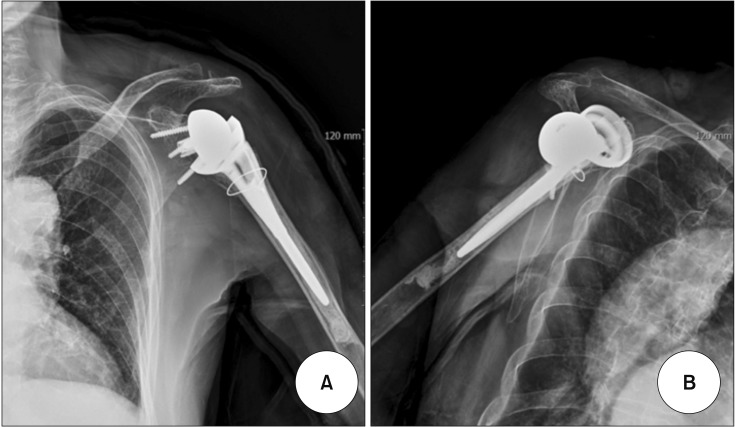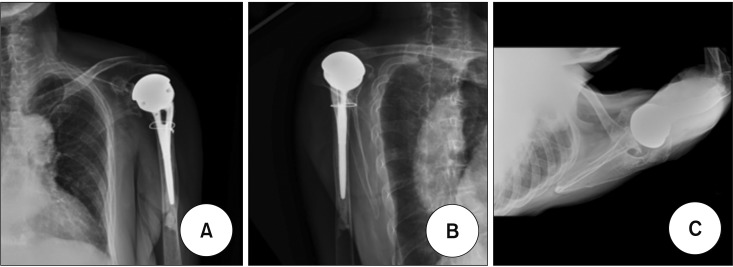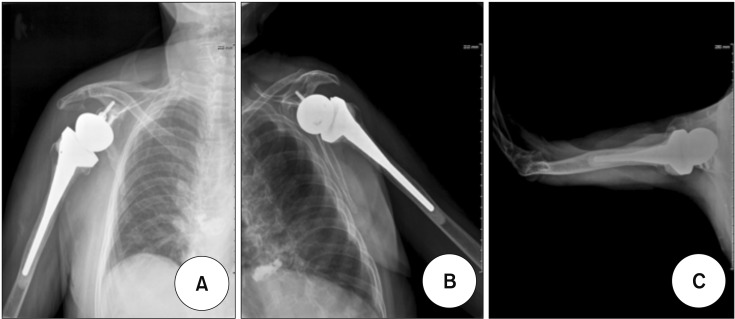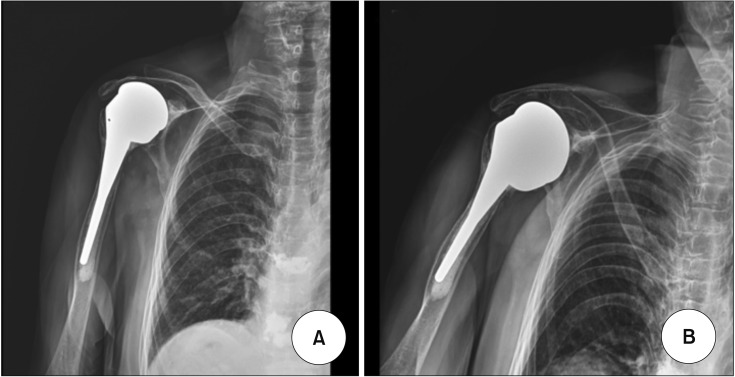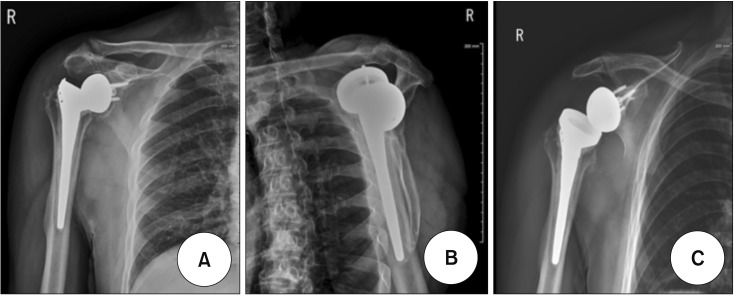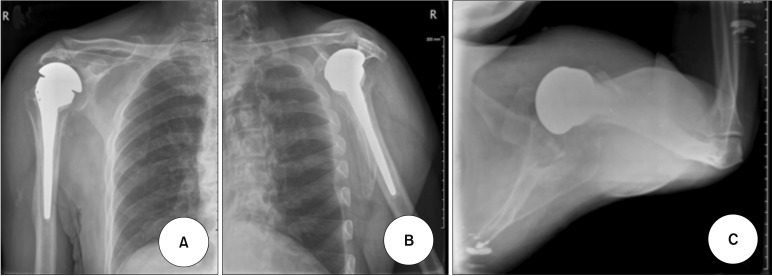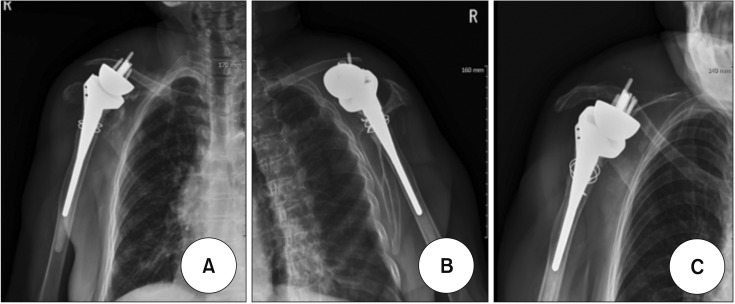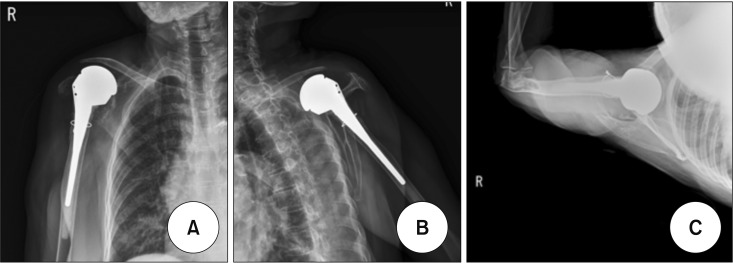Clin Orthop Surg.
2019 Dec;11(4):436-444. 10.4055/cios.2019.11.4.436.
Conversion of Failed Reverse Total Shoulder Arthroplasty to Hemiarthroplasty: Three Cases of Instability and Three Cases of Glenoid Loosening
- Affiliations
-
- 1Department of Orthopaedic Surgery, Daejeon Sun Hospital, Daejeon, Korea. dhj1991@naver.com
- KMID: 2462538
- DOI: http://doi.org/10.4055/cios.2019.11.4.436
Abstract
- BACKGROUND
Glenoid loosening and postoperative instability are common causes of failed reverse total shoulder arthroplasty (RTSA). When soft-tissue problems or large glenoid bone defect interferes with reimplantation in revision RTSA, conversion to hemiarthroplasty can be considered. We present a case series of patients who underwent conversion to hemiarthroplasty due to glenoid loosening and early instability after RTSAs, along with clinical results.
METHODS
A total of 72 primary RTSAs using the Aequalis prosthesis were performed at our institution from May 2009 to December 2016. Of these, five patients, including one with humeral neck fracture and absent rotator cuff and four with cuff tear arthropathy, underwent conversion to hemiarthroplasty. Another patient who had RTSA at a local clinic underwent hemiarthroplasty at our institution for unresolved postoperative anterior dislocation. The mean age of the six patients was 71.7 years (range, 62 to 76 years), and the mean follow-up period was 24.4 months (range, 18 to 30 months). Clinical assessments were conducted by using the visual analog scale (VAS), American Shoulder and Elbow Surgery (ASES) score, and University of California at Los Angeles (UCLA) shoulder score at the last follow-up.
RESULTS
The conversion to hemiarthroplasty in the six patients dramatically improved the mean VAS score (preoperative, 8.1; postoperative, 2.5), ASES score (preoperative, 22.1; postoperative, 56.5), and UCLA score (preoperative, 12; postoperative, 18.1). However, the range of motion was almost unchanged after surgery.
CONCLUSIONS
Conversion to hemiarthroplasty can be a good alternative to revision RTSA in patients with serious complications (such as unresolved instability and glenoid loosening) difficult to treat with revision RTSA.
Keyword
MeSH Terms
Figure
Reference
-
1. Boileau P, Watkinson D, Hatzidakis AM, Hovorka I. Neer Award 2005: The Grammont reverse shoulder prosthesis: results in cuff tear arthritis, fracture sequelae, and revision arthroplasty. J Shoulder Elbow Surg. 2006; 15(5):527–540. PMID: 16979046.
Article2. Cuff D, Pupello D, Virani N, Levy J, Frankle M. Reverse shoulder arthroplasty for the treatment of rotator cuff deficiency. J Bone Joint Surg Am. 2008; 90(6):1244–1251. PMID: 18519317.
Article3. Cuff DJ, Virani NA, Levy J, et al. The treatment of deep shoulder infection and glenohumeral instability with debridement, reverse shoulder arthroplasty and postoperative antibiotics. J Bone Joint Surg Br. 2008; 90(3):336–342. PMID: 18310757.
Article4. Antuna SA, Sperling JW, Cofield RH, Rowland CM. Glenoid revision surgery after total shoulder arthroplasty. J Shoulder Elbow Surg. 2001; 10(3):217–224. PMID: 11408901.
Article5. Black EM, Roberts SM, Siegel E, Yannopoulos P, Higgins LD, Warner JJ. Failure after reverse total shoulder arthroplasty: what is the success of component revision? J Shoulder Elbow Surg. 2015; 24(12):1908–1914. PMID: 26163279.
Article6. Bohsali KI, Wirth MA, Rockwood CA Jr. Complications of total shoulder arthroplasty. J Bone Joint Surg Am. 2006; 88(10):2279–2292. PMID: 17015609.
Article7. Coste JS, Reig S, Trojani C, Berg M, Walch G, Boileau P. The management of infection in arthroplasty of the shoulder. J Bone Joint Surg Br. 2004; 86(1):65–69. PMID: 14765868.
Article8. Zumstein MA, Pinedo M, Old J, Boileau P. Problems, complications, reoperations, and revisions in reverse total shoulder arthroplasty: a systematic review. J Shoulder Elbow Surg. 2011; 20(1):146–157. PMID: 21134666.
Article9. Boileau P, Melis B, Duperron D, Moineau G, Rumian AP, Han Y. Revision surgery of reverse shoulder arthroplasty. J Shoulder Elbow Surg. 2013; 22(10):1359–1370. PMID: 23706884.
Article10. Scarlat MM. Complications with reverse total shoulder arthroplasty and recent evolutions. Int Orthop. 2013; 37(5):843–851. PMID: 23456086.
Article11. Gallo RA, Gamradt SC, Mattern CJ, et al. Instability after reverse total shoulder replacement. J Shoulder Elbow Surg. 2011; 20(4):584–590. PMID: 21167744.
Article12. Levy J, Frankle M, Mighell M, Pupello D. The use of the reverse shoulder prosthesis for the treatment of failed hemiarthroplasty for proximal humeral fracture. J Bone Joint Surg Am. 2007; 89(2):292–300. PMID: 17272443.
Article13. Werner CM, Steinmann PA, Gilbart M, Gerber C. Treatment of painful pseudoparesis due to irreparable rotator cuff dysfunction with the Delta III reverse-ball-and-socket total shoulder prosthesis. J Bone Joint Surg Am. 2005; 87(7):1476–1486. PMID: 15995114.
Article14. De Wilde LF, Plasschaert FS, Audenaert EA, Verdonk RC. Functional recovery after a reverse prosthesis for reconstruction of the proximal humerus in tumor surgery. Clin Orthop Relat Res. 2005; (430):156–162. PMID: 15662318.
Article15. Frankle M, Siegal S, Pupello D, Saleem A, Mighell M, Vasey M. The Reverse Shoulder Prosthesis for glenohumeral arthritis associated with severe rotator cuff deficiency: a minimum two-year follow-up study of sixty patients. J Bone Joint Surg Am. 2005; 87(8):1697–1705. PMID: 16085607.16. Sirveaux F, Favard L, Oudet D, Huquet D, Walch G, Mole D. Grammont inverted total shoulder arthroplasty in the treatment of glenohumeral osteoarthritis with massive rupture of the cuff: results of a multicentre study of 80 shoulders. J Bone Joint Surg Br. 2004; 86(3):388–395. PMID: 15125127.17. Wall B, Nove-Josserand L, O'Connor DP, Edwards TB, Walch G. Reverse total shoulder arthroplasty: a review of results according to etiology. J Bone Joint Surg Am. 2007; 89(7):1476–1485. PMID: 17606786.18. Boulahia A, Edwards TB, Walch G, Baratta RV. Early results of a reverse design prosthesis in the treatment of arthritis of the shoulder in elderly patients with a large rotator cuff tear. Orthopedics. 2002; 25(2):129–133. PMID: 11866145.
Article19. Bufquin T, Hersan A, Hubert L, Massin P. Reverse shoulder arthroplasty for the treatment of three- and four-part fractures of the proximal humerus in the elderly: a prospective review of 43 cases with a short-term follow-up. J Bone Joint Surg Br. 2007; 89(4):516–520. PMID: 17463122.20. Guery J, Favard L, Sirveaux F, Oudet D, Mole D, Walch G. Reverse total shoulder arthroplasty: survivorship analysis of eighty replacements followed for five to ten years. J Bone Joint Surg Am. 2006; 88(8):1742–1747. PMID: 16882896.21. Paladini P, Collu A, Campi E, Porcellini G. The inverse prosthesis as a revision prosthesis in failures of shoulder hemiarthroplasty. Chir Organi Mov. 2005; 90(1):11–21. PMID: 16422225.22. Rittmeister M, Kerschbaumer F. Grammont reverse total shoulder arthroplasty in patients with rheumatoid arthritis and nonreconstructible rotator cuff lesions. J Shoulder Elbow Surg. 2001; 10(1):17–22. PMID: 11182731.
Article23. Seebauer L, Walter W, Keyl W. Reverse total shoulder arthroplasty for the treatment of defect arthropathy. Oper Orthop Traumatol. 2005; 17(1):1–24. PMID: 16007376.
Article24. Grammont PM, Baulot E. Delta shoulder prosthesis for rotator cuff rupture. Orthopedics. 1993; 16(1):65–68. PMID: 8421661.
Article25. Gohlke F, Rolf O. Revision of failed fracture hemiarthroplasties to reverse total shoulder prosthesis through the transhumeral approach: method incorporating a pectoralis-major-pedicled bone window. Oper Orthop Traumatol. 2007; 19(2):185–208. PMID: 17530198.26. Wall BT, Mottier F, Walch G. Complications and revision of the reverse prosthesis: a multicenter study of 457 cases. J Shoulder Elbow Surg. 2007; 16(2):e55.
- Full Text Links
- Actions
-
Cited
- CITED
-
- Close
- Share
- Similar articles
-
- Treatment of instability with scapular notching and glenoid component loosing by partial mixed different implant revision
- A humeral hemiarthroplasty with biologic resurfacing of the glenoid using an allo-Achilles tendon: two case reports
- Clinical and Radiological Results of Reverse Total Shoulder Arthroplasty Using a 25-mm Glenoid Baseplate
- Etiology and Treatment of Revision Shoulder Arthroplasty
- Concomitant Fractures of the Coracoid and Acromion after Reverse Total Shoulder Arthroplasty

